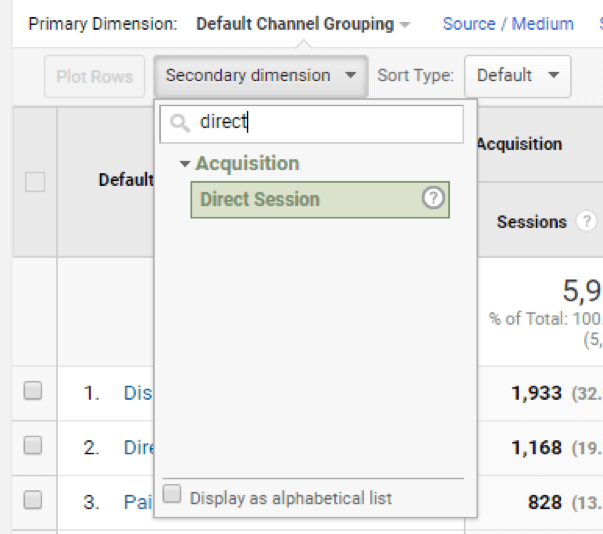Step-by-Step Overview: Leveraging Secondary Dimension in Google Analytics
Step-by-Step Overview: Leveraging Secondary Dimension in Google Analytics
Blog Article
Enhance Your Data Evaluation Making Use Of Secondary Dimension in Google Analytics
Checking out the capacities of additional dimensions in Google Analytics opens up a realm of possibilities for refining information analysis. By layering extra measurements onto primary data sets, a more detailed narrative arises, dropping light on individual communications and performance indications.
Comprehending Second Dimensions
In the realm of data evaluation, a crucial facet to grasp is the principle of secondary dimensions and their value in drawing out deeper understandings from Google Analytics records. Second dimensions in Google Analytics refer to added parameters that can be included in the key measurement, allowing for a more comprehensive evaluation of data. By including second measurements, experts can segment and filter data to discover patterns, patterns, and relationships that could not be evident when taking a look at the data all at once. These second dimensions can provide context and a more detailed understanding of individual actions, traffic sources, and other crucial metrics tracked by Google Analytics.

Advantages of Utilizing Secondary Dimensions
When evaluating data in Google Analytics, the utilization of secondary measurements offers invaluable understandings into customer actions and efficiency metrics. By including an additional dimension to your key data, you can dive deeper right into the attributes of your website site visitors and their interactions. Among the essential advantages of utilizing secondary measurements is the ability to segment and contrast information extra effectively. This segmentation permits you to understand just how different variables, such as demographics or website traffic sources, impact customer behavior and conversions (Secondary Dimension in Google Analytics).
Moreover, additional dimensions assist in identifying patterns and relationships that might not be quickly apparent when looking at the information in seclusion. This much deeper degree of analysis can reveal important info that can assist advertising and marketing approaches, website optimization, and overall company decisions. Furthermore, additional measurements boost the context of your main information, providing a more extensive view of individual interaction and performance metrics. Generally, the use of additional dimensions in Google Analytics can dramatically boost the depth and high quality of your data analysis, leading to even more educated decision-making and enhanced outcomes.
Just How to Include Secondary Dimensions
By including additional measurements in Google Analytics, customers can obtain much deeper insights right into their information evaluation procedure, permitting for more extensive assessment of customer actions and efficiency metrics. Including second dimensions is a simple process that can considerably boost the deepness of analysis. When in the record, find the "Secondary dimension" tab above the data table.
Analyzing Information With Additional Measurements
Making use of secondary dimensions in information evaluation offers an extra thorough understanding of customer habits and performance metrics. By including a secondary dimension to your main data established in Google Analytics, you can dig much deeper right into the features of your web site visitors and their interactions. For instance, incorporating the key measurement of 'source/medium' with the additional dimension of 'landing page' can reveal which particular pages are bring in website traffic from various resources, assisting you maximize these pages for better involvement.

In significance, assessing information you could check here with secondary measurements encourages you to acquire useful insights into individual habits, identify fads, and make educated decisions to enhance the performance of your electronic buildings.
Ideal Practices for Secondary Measurements
In data analysis, including second dimensions properly can significantly enhance the deepness of understandings acquired from metrics and user habits patterns. When making use of second measurements in Google Analytics or any kind of other logical tool, it is important to comply with best techniques to guarantee the accuracy and relevance of the data evaluation.
One secret finest technique is to carefully choose second dimensions that enhance the primary dimension being examined. Picking secondary dimensions that offer added context or further segmentation can supply a much more detailed understanding of the data. It is additionally important to avoid overcomplicating the analysis by consisting of a lot of second dimensions, which might bring about confusion or dilution of insights.
Moreover, it is advisable to trying out various combinations of primary and my link secondary measurements to uncover new connections and fads. On a regular basis improving the choice and examining of second dimensions based on the details goals of the analysis can lead to even more workable insights. By complying with these best techniques, data analysts can take advantage of additional measurements successfully to enhance the general information evaluation process and decision-making abilities.
Verdict
To conclude, integrating additional dimensions in Google Analytics is vital for a detailed information evaluation method. By leveraging secondary measurements together with main ones, analysts and marketers can discover useful insights and connections that can educate decision-making and optimize digital advertising techniques. Comprehending just how to effectively utilize additional measurements and adhering to best practices will certainly permit professionals to remove purposeful data and improve their overall performance metrics.
Second dimensions in Google Analytics refer to added specifications that can be added to the key measurement, enabling for an extra comprehensive evaluation of data. By including additional dimensions, experts can segment and filter data to reveal patterns, patterns, and correlations that could not be obvious when looking at the data as a whole. Combining the main measurement of 'source/medium' with the secondary measurement of 'landing web page' can expose which details web pages are attracting website traffic from various sources, aiding you enhance these pages for far better interaction.
One key finest method is to carefully select additional measurements that complement the main dimension being evaluated. By adhering to these best techniques, information analysts can take advantage of secondary dimensions properly to boost the overall information analysis process and decision-making capacities.
Report this page